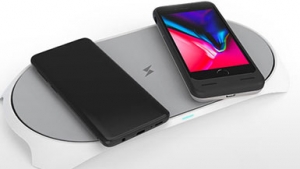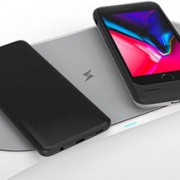The Need for Wireless Charging Is Clear
By Paul Wiener, VP of Strategic Marketing for GaN Systems
Wireless charging, more generally referred to as wireless power transfer or wireless energy transmission, is on its way to becoming mainstream. Yet, developing products that feature the benefits users want has its challenges. Take the recent news from Apple announcing the cancellation of its AirPower wireless charging product, which had been in the works for more than eighteen months.

SkyCurrent III
The SkyCurrent III is the only dual-mode wireless charging solution that embeds Airfuel Alliance magnetic resonant for ‘fast charging’ and Qi technology.
At APEC 2019 – one of the world’s largest power electronics conferences, wireless power charging was a noteworthy discussion among attendees as they walked past numerous exhibitors showcasing wireless power solutions. GaN Systems is a steadfast believer in revolutionizing wireless charging, as a world without cords becomes a reality. Rather than plugging a device into a power source via a power cable, wireless charging enables a device to receive power from a transmitting unit by simply being near it.
The needs for wireless charging are clear:
- Spatial freedom in X-Y-Z directions
- Rapid charging
- The ability to simultaneously charge multiple devices at various power levels
- A scalable and interoperable global infrastructure
In the case of Apple, the company chose Qi technology for its devices and hence their AirPower transmitter needed to be compatible with this technology. Whether there were technical challenges that could not be overcome or cost issues that made the solution too expensive, it appears that the Qi based technology presented barriers that could not be overcome.
Shelving AirPower is a Step Forward – In the Right Direction
At first glance, Apple’s cancellation of AirPower might seem like a big blow for wireless power adoption. Yet – we believe that it was a necessary and major step forward as wireless power transfer and charging develops to highlight that other technologies are likely better solutions.
- While Apple AirPower did not launch, technologies such as magnetic resonance are receiving market acceptance and maturing quickly to overcome the current technical challenges in the market.
- Companies like GaN Systems, PowerSphyr, and NuCurrent have shown existing products that address the challenges with today’s technology.
- Several industries outside the mobile phone market have launched products into market leveraging magnetic resonance, such as drones, autonomous guided vehicles, and robots.
In hindsight, the stumbling block for wireless charging occurred several years ago when Apple first embraced Qi wireless power transfer. Fortunately, alternative technologies are maturing. They have industry standards to back them up and many companies have already implemented with them. Let’s see if the mobile phone industry follows suit.


